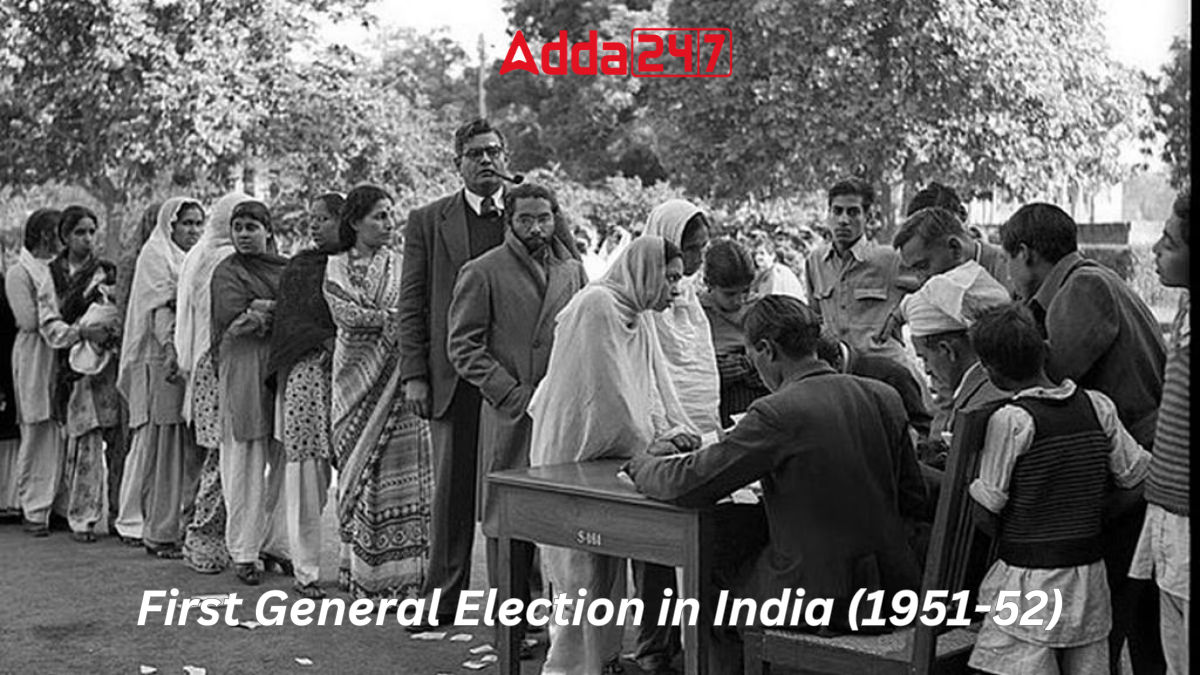First General Election in India (1951-52), Know the Date and Key Facts [Current Affairs]
[ad_1]
India’s journey towards democracy is marked by a pivotal milestone — the First General Election held in 1951-1952. This monumental event not only shaped the course of Indian politics but also laid the foundation for the world’s largest democratic experiment. Let’s delve into the significance, challenges, and triumphs of India’s inaugural democratic exercise.
First General Election in India
India’s journey towards establishing itself as a sovereign, socialist, secular, and democratic republic reached a significant milestone with the commencement of the First General Election on October 25, 1951. After years of struggle for independence, the nation was now poised to embrace the principles of universal adult suffrage and conduct a massive electoral exercise.
First General Election in India (1951-1952) – Key Events
Formation of the First Lok Sabha: The inaugural Lok Sabha was elected during the first general elections, marking a crucial step in shaping the democratic landscape of independent India.
Transition from Interim Legislature: Since August 1947, India had been governed by an interim legislature known as the Indian Constituent Assembly. The First General Election paved the way for a more representative and permanent legislative body.
Universal Adult Suffrage: A groundbreaking aspect of the election was the implementation of universal adult suffrage, allowing every citizen over the age of 21 to exercise their right to vote, irrespective of caste, creed, religion, gender, or socio-economic status.
Scale and Participants: A total of 53 political parties contested for 489 seats, with 1874 candidates vying for victory. The election covered 401 constituencies, some of which had multiple seats. Notably, the multi-seat constituencies were eliminated in the 1960s.
Voter Turnout and Representation:Out of a population of 36 crores, approximately 17.32 crores were eligible to vote, resulting in a noteworthy 45% turnout. The Indian National Congress (INC) dominated the elections, winning 364 seats, securing nearly 45% of the votes. The Communist Party of India (CPI) came second with 16 seats.
Mock Election and Election Commissioner: To familiarize citizens with the election process, a mock election was conducted in September 1951. Sukumar Sen served as the first Election Commissioner of India, overseeing the fair and efficient conduct of the electoral process.
Prominent Winners and Losses: Key figures like Jawaharlal Nehru, Lal Bahadur Shastri, Sucheta Kripalani, Gulzari Lal Nanda, and Shyama Prasad Mukherjee emerged as prominent winners. However, B.R. Ambedkar faced defeat in the Bombay (North-Central) seat, losing to INC candidate Narayan Sadoba Kajrolkar.
Highlights of the Results of First General Election of India
The table below outlines the major parties, their respective votes, and the seats they secured:
| Major Parties | No. of Votes | Seats Won |
| Indian National Congress | 47,665,875 | 364 |
| Communist Party of India | 3,484,401 | 16 |
| Bhartiya Jana Singh | 3,246,288 | 3 |
| Socialist Party | 11,266,779 | 12 |
| Kisan Mazdoor Praja Party | 6,156,558 | 9 |
| Independents | 16,817,910 | 37 |
Noteworthy Facts and Figures of First Lok Sabha (1852-1957)
- The first Lok Sabha, lasting from April 1952 to April 1957, had a record 677
- V. Mavalankar served as the Speaker of the first Lok Sabha.
- Ravi Narayana Reddy, representing the People’s Democratic Front, was the first person to enter Parliament, outvoting even Nehru in the first general elections.


![NVIDIA And Indian Govt Join Forces For Sovereign AI [Current Affairs]](https://officialsarkar.in/wp-content/uploads/2024/02/Untitled-design15-1568x882-768x432.png)
![PM Modi Virtually Launches Agra Metro [Current Affairs]](https://officialsarkar.in/wp-content/uploads/2024/03/Untitled-design79-1568x882-768x432.png)
![Top-10 Famous Indian Cricketers By March 2024 [Current Affairs]](https://officialsarkar.in/wp-content/uploads/2024/03/Top-10-Famous-Indian-Cricketers-768x432.png)
![Taylor Swift cheers on boyfriend Travis Kelce at Super Bowl | Entertainment News [World]](https://officialsarkar.in/wp-content/uploads/2024/02/AP24042845042902-1707696644-768x576.jpg)
![Senior Bureaucrat Rahul Singh Appointed New CBSE Chief [Current Affairs]](https://officialsarkar.in/wp-content/uploads/2024/03/Senior-Bureaucrat-Rahul-Singh-Appointed-New-CBSE-Chief-1568x882-768x432.jpg)
![India’s forex reserves jump to over two-year high of $636.1 bn [Current Affairs]](https://officialsarkar.in/wp-content/uploads/2024/03/IMG_Hand_putting_coins_o_2_1_R2CH1COQ-768x472.jpg)